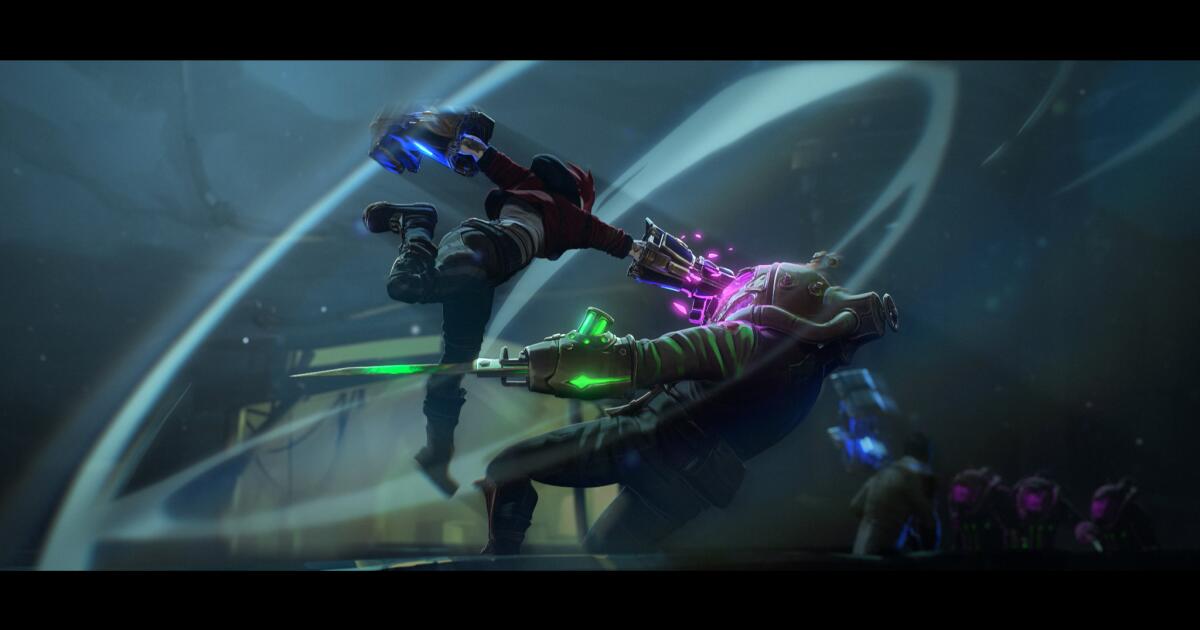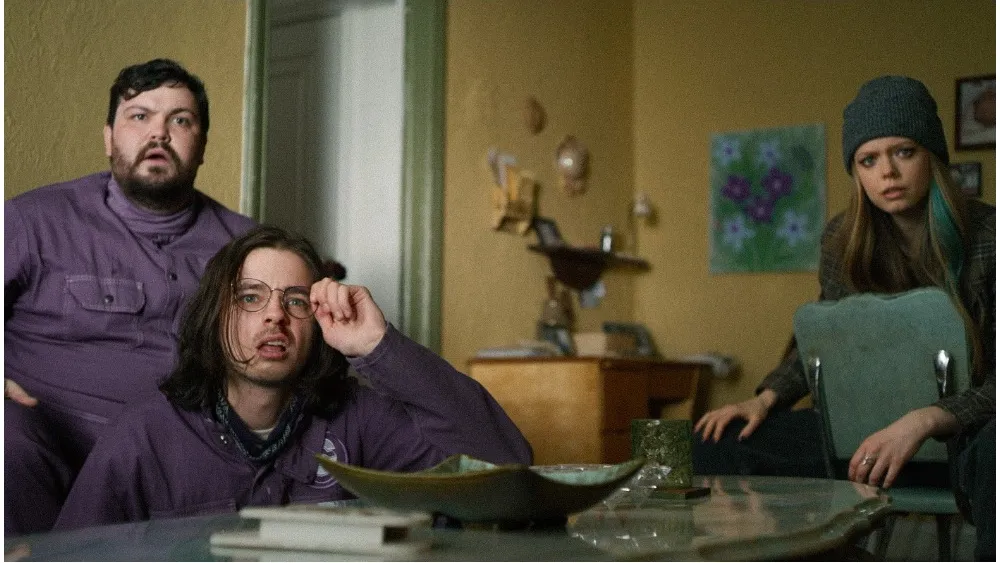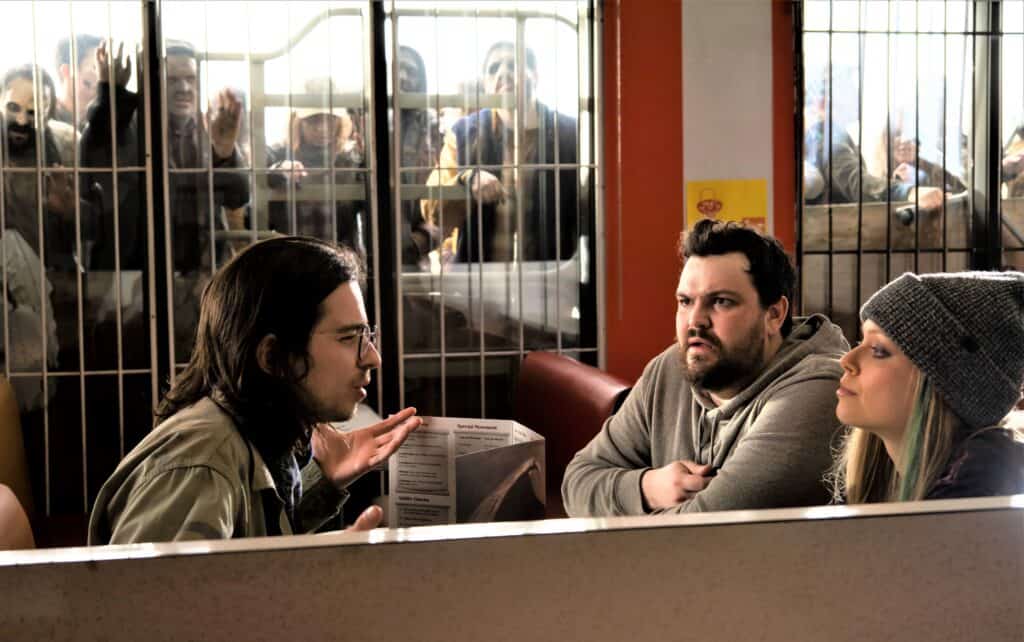Entertainment
Popular Netflix shows leaked in security breach. Company 'aggressively taking action'

A security breach at one of Netflix’s production partners caused yet-to-be released episodes of popular shows to leak online this week.
“One of our post production partners has been compromised and footage from several of our titles has unfortunately leaked online,” Netflix said in a statement Friday. “Our team is aggressively taking action to have it taken down.”
Netflix declined to comment on which titles were affected, but tech news outlet IGN reported on Thursday that the leak included episodes Season 2 of animated series “Arcane,” a series based on the world of the popular video game “League of Legends.” The second season is set to be released on Netflix in November.
Season 3 of popular coming of age series “Heartstopper,” expected to launch on Oct. 3, also was leaked, according to What’s On Netflix.
Burbank-based post-production firm Iyuno, which offers dubbing and subtitling services, said in a statement that it “is aware of a recent security issue, involving access to confidential content.”
“Protecting our clients’ confidentiality and ensuring the security of their content is our highest priority,” Iyuno said. “We are actively investigating this security breach to mitigate any potential risks and identify the responsible parties. When there are material changes or information we will make further statements.”
Leaks of unreleased shows are a point of frustration among the companies and people who work on them. Pirated versions of shows cannibalize streaming platforms’ viewership, especially if they’re released prematurely.

Movie Reviews
Film Review: We Are Zombies

At the beginning of 2019’s “Zombieland: Double Tap,” the film’s fourth-wall breaking narration strikes a tone that’s both wry and earnest: “You have a lot of choices when it comes to zombie entertainment,” it observes. It’s a comment that would seem positively bizarre just 20-odd years ago, before numerous artists in film, comics, television and more sought to resurrect their fond childhood memories of George A. Romero films, Italian horror rip-offs and gonzo splatter comedies, causing the zombie to become as much of a cultural mainstay as vampires, ghosts and werewolves.
Now that we’re well past the zombie revival phenomenon, we’ve entered a sort of post- post-modern phase when it comes to the living dead. It’s no longer novel to make a ribald zombie comedy, and the most predominant metaphors and allegories concerning the creature have been nearly done to death. Unless the zombie lays dormant for a while, there may not be much new to say about or with them.
Yet pushing the envelope in the arts and entertainment isn’t paramount; if it were, we wouldn’t have sequels and remakes and reboots and the like. What counts for a lot is sincerity, and that’s a quality that the film collective known as RKSS has in abundance. RKSS — Quebeckers individually known as François Simard, Anouk Whissell, and Yoann-Karl Whissell — first burst onto the scene with 2015’s “Turbo Kid,” a feature that showcased their geek culture bonafides as well as their penchant for combining the wholesome with the gruesome.
Their follow-up, “Summer of ’84,” took an impressive turn into genuinely dark territory, indicating that they may be adding some compelling maturity to their work going forward. Their first feature since then, “We Are Zombies,” pumps the brakes on that idea. But no matter; even though the film is, with its adult protagonists, ironically more juvenile than their first two films about children were, it’s still a charming zom-com romp.
Based on the comic series “The Zombies That Ate the World” by Jerry Frissen, “We Are Zombies” sees RKSS (who have jumped back on writing duties here for the first time since “Turbo Kid”) employ their clever economy when it comes to world building, explaining with just a short opening credits montage the idea that the dead have started coming back to life, but instead of turning into ravenous flesh-eating ghouls, they simply wander (or sit) around, taking up space.
They are, in effect, a new minority population, and although they’re given basic rights (including being referred to as the “Living Impaired”), humans are becoming perturbed by their growing numbers. To try and address that, officially licensed groups offering “retirement services” offer to take rotting loved ones off people’s hands. Seeing as how living corpses can fetch a good price on the black market, some enterprising people choose to hack into official systems and pose as retirement servicemen, and this is exactly what Freddy (Derek Johns), Karl (Alexandre Nachi), and Karl’s half-sister Maggie (Megan Peta Hill) do.
Unfortunately, this misfit trio finds their get-rich-quick grift beset on many sides, namely by the actual servicemen they’re stealing zombie pickups from: Stanley (Patrick Abellard) and Rocco (Marc-André Boulanger), who work for the Coleman corporation. Hannity (Benz Antoine), a former military man and current Coleman head honcho, refuses to pay Stanley and Rocco until they repay the company their debts, eventually leading the doofus duo to kidnap Karl and Maggie’s sweet old grandmother (Clare Coulter) as collateral until the black market trio can scrounge up some money.

In order to do that, Karl uses a connection to get a job from an avant-garde artist/musician (Stéphane Demers), who wants them to literally dig up a celebrity Living Impaired to have as his date. Meanwhile, Hannity is making waves at Coleman, insisting that the Living Impaired population is growing too large, and begins planning to unleash an experimental chemical which will turn the LI into ravenous zombies and lead to, he hopes, the elimination of all the undead.
The comic book origins of “We Are Zombies” are present in all of this world building, and it isn’t too hard to see how a series (be it comic, film, or TV) could be spun off from it. Yet RKSS aren’t so craven as to position the film as part one of several. Instead, the movie is firmly focused on being a Coen Brothers-esque caper, as our so-called heroes make as many mistakes as they have victories.
Unlike the work of the Coens, there isn’t a ton of satiric bite to be found here; the slacker-humor dialogue is only edgy if you’re still a teenager, and some of the script’s attempts to be politically incorrect feel more feeble than sharp. Still, the idea that zombies and humans are both highly foolish (with humans edging out zombies in stupidity) is potent enough to lend the film a nice undercurrent of misanthropy.
Where “We Are Zombies” really shines is in its display of RKSS’ mix of ribald humor, violence, and open-hearted charm. Many of the hallmarks of the directing trio’s work can be seen in the film: nerd culture being openly celebrated, a badass blonde girl (who’s verbally referred to as such), a penchant for set-ups and pay-offs, the slick cinematography of Jean-Philippe Bernier (as well as his synthwave music, along with Jean-Nicolas Leupi, under the name of Le Matos), and so on.
There aren’t any standout performances as with RKSS’ previous films, but the ensemble as a whole works really well together, especially when tasked with selling various romantic couplings that are a little half-baked (which the script comments on, to its credit). More than anything, the movie feels genuinely personal, an increasingly rare thing in a media landscape saturated with zombie entertainment: it’s no coincidence that Karl, Freddy and Maggie are essentially the three filmmakers’ alter egos. To paraphrase “Zombieland: Double Tap,” you have a lot of choices when it comes to new zombie movies, and if you choose “We Are Zombies,” you’re at least likely to have a good time.
Soundsphere Rating: Three and a Half Stars
Movie Reviews
Borderlands (2024) – Movie Review

Borderlands, 2024.
Directed by Eli Roth.
Starring Cate Blanchett, Kevin Hart, Jack Black, Jamie Lee Curtis, Edgar Ramírez, Ariana Greenblatt, Florian Munteanu, Gina Gershon, Haley Bennett, Janina Gavankar, Cheyenne Jackson, Charles Babalola, Benjamin Byron Davis, Steven Boyer, Ryann Redmond, Bobby Lee, Olivier Richters, Justin Price, and Paula Andrea Placido.
SYNOPSIS:
Based on the best-selling videogame, this all-star action-adventure follows a ragtag team of misfits on a mission to save a missing girl who holds the key to unimaginable power.

An adaptation of the popular cooperative multiplayer open-world video game series, Borderlands doesn’t play to the strengths of exploration or the strengths of co-writer/director Eli Roth as a shock filmmaker. The ultraviolent horror guru seems like an inspired choice on paper, considering these are Mature-rated games that also derive energy and excitement from gore and juvenile humor (typically referencing pop culture or smartly deconstructing video game tropes), but he has bafflingly been given a PG-13 rating to work with. To be fair, one can also imagine this turning out just as lifeless and generic even if Eli Roth and co-writer Joe Crombie had been given the green light to do whatever they wanted because they seem to fundamentally not understand what anyone likes about these games and are packaging it into a cinematic interpretation devoid of any personality.
Simultaneously, not all of these shortcomings should necessarily be attributed to the filmmakers. Borderlands isn’t exactly the type of video game property with strong storytelling or beloved heroes that scream for an adaptation. However, given the game’s visual color and humorous dialogue, there is reason to believe this could work if it elicits laughter and delivers fun variations of the playable characters and sidekicks, possibly fleshing them out in the process. Here, the attempts at comedy are forced to the point of cringe, whereas the story is a generic tale about a teenage girl theorized to have special abilities capable of opening a hidden vault many have tried hunting for.

Everything here is lifeless to the point where it is also a struggle to find things to say, so here’s an anecdote about my opening-night screening (this film was not screened for press in Chicago.) 15 minutes into the film, a random man walks in and sits down, most likely sneaking in after having just finished watching something else. He left after five minutes, presumably because the snarky humor was bombing, the plotting was basic, the action was bland, and the visuals were dull and complemented by costumes that feel more like high-end cosplay.
Cate Blanchett is the redhaired Lilith, a bounty hunter employed by Atlas (Edgar Ramirez) to rescue his daughter Tiny Tina (a fan-favorite played by Ariana Greenblatt) from one of his soldiers, Roland (a completely miscast Kevin Hart), aware that she is disposable to her father and locked away, only being used to one day open the vault when it is discovered. Meanwhile, one of the Mad Max-inspired masked psychos (Florian Munteanu) serves as a brute bodyguard for Tiny Tina. Three keys must be collected beforehand; this is based on a video game, after all. Unsurprisingly, everyone comes together and finds themselves on the same side, fighting against Atlas while searching for these keys.

As a game, there would be ample time to run off and cross paths with several kooky side characters offering up side missions that would give the consumer a sense of this world overrun by greedy corporations (a thematic thread the film does nothing with.) Or maybe it would be the right time to dig into the unique shooter mechanics that prioritized exploring and killing as much as possible to be rewarded with special weapon drops of varying damage levels and distinct traits (as far back as the first game, there were thousands of possibilities regarding these sometimes randomly generated firearms.)
Instead, Borderlands is rushing through this generic story (that smashes together multiple aspects and characters from all three games until it comes across as an overstuffed mess, similar to far too many other video game adaptations) like a player only concerned with speeding their way through the plot-centric quests, that’s not the right way to play Borderlands, and that for damn sure isn’t the correct way to adapt it.

Some other characters join the adventure, ranging from comedic robot sidekick Claptrap (for some reason voiced by Jack Black even though it sounds nothing like him and Lionsgate didn’t bother to market the movie, meaning it wouldn’t have mattered just giving the role to voiceover performer David Eddings again) and Jamie Lee Curtis’ scientifically inclined Tannis (doing almost nothing in the movie but spouting exposition even though she tags along, making it feel like that fourth person in the party who doesn’t provide any real assistance and just racks up Achievements from everyone else’s hard work.)
No matter who they are, everyone feels halfway committed to their video game counterpart in screenplay construction. The bigger issue is that, in doing so, the filmmakers never figure out who these characters are or why anyone should care about them. Technically, you could say the film looks like Borderlands, but even that statement only goes so far since the adaptation is robbed of the aesthetically pleasing cel-shaded animation. The song choices for the action sequences are seemingly selected at random, with encounters against even giant monstrosities lasting about as long as they do in the trailer.

Everything here feels desperate to convince viewers that everyone involved gets and understands Borderlands, which couldn’t be farther from the truth. There is hesitation in calling the film awful since the actors are trying, and there is a base-level competence to the proceedings, but this is a bore with zero personality.
Flickering Myth Rating – Film: ★ ★ / Movie: ★
Robert Kojder is a member of the Chicago Film Critics Association and the Critics Choice Association. He is also the Flickering Myth Reviews Editor. Check here for new reviews, follow my Twitter or Letterboxd, or email me at MetalGearSolid719@gmail.com
https://www.youtube.com/watch?v=embed/playlist
Entertainment
Isaac Psalm Escoto finds the intersection between L.A.’s art galleries and graffiti

“My car got impounded again. I am so sorry I’m late,” said Isaac Psalm Escoto, practically running into Jeffrey Deitch, a contemporary art gallery on Santa Monica Boulevard, energy drink in hand.
It was the second night in a row that his 2006 Scion xA got towed. Escoto, also known by the graffiti alias Sickid, is on a tight deadline to finish the final installment in his first solo exhibition, “Gas Station Dinner.” From the crevice of his ear to the shoelaces on his Converse sneakers, he’s covered entirely in unintentional paint splatters.
The unfinished piece is a 20- by 60-foot canvas wall that mimics a billboard — a size the graffiti artist is well acquainted with. The painting depicts a cityscape that brings together imagery from Escoto’s artistic world of dysfunction. A massive woman is sprawled across the horizon. Her body is framed by warped skyscrapers branded with Cup Noodles, the Playboy Bunny, Western Exterminators’ mascot, Mr. Little, and a blimp reading, “Ice Cube’s a Pimp.” Below the woman, the chaos of the city ensues, including depictions of a car accident, a police chase, a wounded skater, a strip of discount stores and a piano-playing duo. The spray-painted mural is complete with the religious imagery of a crucifix and several battling angels and devils wreaking havoc. All of Escoto’s work is set in this florescent realm of mischief and humor.
Isaac Psalm Escoto pauses in front of one of his works in “Gas Station Dinner.”
(Robert Gauthier / Los Angeles Times)
Inspired by his diet of 7-Eleven hot dogs and taquitos, the 25-year-old painter came upon the name “Gas Station Dinner” as both a joke and a tribute to the people in his life who have stuck by him and his art. The show will be on display until Aug. 10. Walking the line between hyper-realism and hyperbole, his ambiguous reality is inhabited by characters with brown skin, pointy eyeballs, rosy cheeks and rug-burned knees.
Escoto also exhibits a series of canvases featuring characters in acts of misconduct. They are pictured punching the screen of a Taco Bell drive-thru menu, chainsawing an ankle monitor and pointing a gun from behind the counter of a convenience store. No matter how outrageous the characters’ behavior, the artist grounds them in familiar settings such as a messy bedroom, a grocery store and a gas station bathroom.
In the gallery’s back room are a series of smaller-scale works that continue to explore points of view within the context of Escoto’s world. In some paintings, viewers are looking at the world through a microwave door, a fishbowl or a security camera lens.
“I’m inspired a lot by my viewing history of different forms of media. I’ll take something that was super impactful, like ’90s anime that inspired ‘The Matrix’ and ‘Blade Runner.’ Those kinds of things depict cities with a dystopian tone and mix it with culturally rich, diverse and funny imagery,” Escoto said. “I look to Eastern ways of shelling futuristic cities and landscapes and fuse them with my ideas of modern Los Angeles lifestyle.”
The show is a product of Escoto’s first official practice at Tlaloc Studios, where he focused on painting. Before landing a coveted spot at the artist-run studio in South Central L.A., he worked out of a space he created within his mother’s walk-in closet. Over the last three years, Ozzie Juarez, founder of Tlaloc Studios and a fellow artist, has witnessed Escoto transition to bigger-scale works and continuously introduce new techniques.
“When I look at [Escoto’s] paintings, I see an artist that’s enjoying himself while making work,” said Juarez. “The amount of work he puts in tiny sections throughout his paintings is ridiculous. It’s those details that really give you an insight of who Isaac is, what his personality is like and, above all, what it’s like to grow up as Latino in Los Angeles.”
Escoto’s parents emigrated from Mexico and Guatemala. As he reflects on his childhood in East Hollywood, he says the neighborhood helped form his “opinions and viewpoints.”
The works included in “Gas Station Dinner” showcase Escoto’s ability to flesh out his world, where “uncommonality becomes the mundane” and his devious characters are free to run amok.
“It’s a city that’s shaped by other cultures from other countries and by the immigrant lifestyle. That’s kind of how I view my city,” Escoto said. As he says “my city,” he lets out a laugh.
Alongside the inventive cityscape, Escoto’s work is deeply rooted in humor. Making fun of modernity while portraying absurdity is a balance he is well acquainted with. In the painting where a woman aims a gun from behind a convenience store counter, she is surrounded by SpongeBob SquarePants bongs, a wall of sex pills and potato chip bags with rappers’ faces on them.
“It’s not necessarily putting a bow on it or trying to romanticize a delinquency or dysfunction. Instead, I’m just putting out an image saying, ‘This is reality, and it’s not necessarily good or bad,’” said Escoto.
Although this is Escoto’s first major gallery exhibition, Los Angeles is already well acquainted with his work. Before he put his characters on canvases, he spent years painting them all over the city under the guise of Sickid. Instead of tagging his name like other graffiti artists, he is known for creating intricate scenes on billboards, the sides of buildings, bus stops and abandoned storefronts.
From a red devil baby urinating on an obstructed wall in Chinatown to outlandish depictions of luchadores, police officers and angels on an Echo Park billboard, Escoto first found his artistic style as a graffiti-addicted teenager.
He adopted the practice at age 14, spending weeknights sneaking out at all hours to draw his characters around town.
“I was lucky enough to have supportive older siblings who took me to the places that were like gateway drugs to a deeper art experience,” said Escoto.
They first took him to Meltdown Comics, a beloved, now closed comic shop in West Hollywood that specialized in all things comedy and collectibles. Upon entering the storefront, everything changed for him. He equates the experience to entering an art museum for the first time; it was an introduction to a whole new world where he could blend the grit of graffiti with the lively spirit of comics.
“Graffiti is an empowering act because it’s so lawless, and there are consequences to it. So maybe it’s lawful. I don’t know,” Escoto said. “It puts my brain in a place where I put out only images I want to.”
The urgency of graffiti helped him commit to imagery and build confidence as an artist. Saving his “weirder subject matter” for the studio, he found that in the streets he didn’t need to worry about perfection.

Isaac Psalm Escoto is working on a tight deadline for his debut exhibition.
(Robert Gauthier / Los Angeles Times)
“What matters most is what you’re trying to come across in a piece. It’s all about your intention behind it and how are you trying to communicate that,” Escoto adds.
The namesake and owner of the gallery, Jeffrey Deitch, first discovered a Sickid billboard while driving on the 101 Freeway. Allured by the eye-catching imagery, he knew he had to meet the artist.
“Isaac is painting a different kind of L.A. that we all know. It’s those little convenience stores inside gas stations, the rack of products in car washes and the interior of liquor stores,” said Deitch. “He introduces us to that world which we all know but we haven’t seen yet in art. It’s a very interesting thing how he captures this essential aspect of contemporary Los Angeles.”
As Escoto enters his mid-20s, he‘s realized that the true theme of his work is rooted in the struggles that come with adulthood and wanting to return to a childlike place of comfortability.
“A lot of pieces are not biographical but I’m projecting myself into a lot of my subject matter. I live vicariously through my figures, and that’s the basis of the painting,” said Escoto. “I’m depicting the struggles and insecurities of growing up and trying to find yourself through dysfunction.”
Hence the need for gas station dinners.
“As I was sketching the mural with the big extension roller with no ladder, an extreme sense of gratitude came over me, like this is what I would do down the street on a billboard,” Escoto said. “I’m using the same hand, and it’s like I’m looking up at a black billboard, but I’m on the inside of Jeffrey Deitch.”
-

 Mississippi1 week ago
Mississippi1 week agoMSU, Mississippi Academy of Sciences host summer symposium, USDA’s Tucker honored with Presidential Award
-

 World1 week ago
World1 week agoWhy are fewer women winning EU leadership roles?
-

 Politics1 week ago
Politics1 week agoVance brands Harris a 'coward'; Trump dinged for 'attacks and insults' as campaigns war after fiery event
-

 News1 week ago
News1 week agoWe the People: Gun Rights : Throughline
-

 World1 week ago
World1 week agoThe Take: Is Silicon Valley going MAGA?
-

 News1 week ago
News1 week agoVideo: Biden and Harris Greet Americans Released From Russia
-

 Politics1 week ago
Politics1 week agoHouse conservative who's twice moved to impeach Vice President Harris faces competitive GOP primary
-

 World1 week ago
World1 week agoIsrael subjecting Palestinian detainees to torture and abuse: UN report














